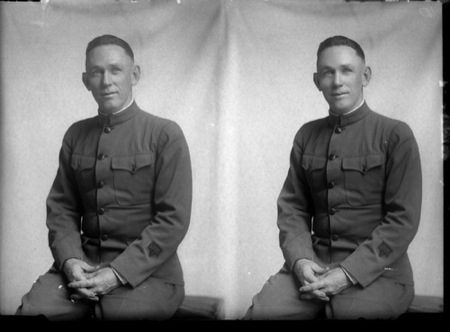-
The ignominious end of an era.
Month: November 2009
Discovering J.A. Morrow
There are two composers who pop up more consistently on recordings of the Virginia Glee Club than any other, across the years: E. A. Craighill, who is generally (though not completely correctly) credited with composing the “Good Old Song,” and J.A. Morrow, who composed the University’s official alma mater, “Virginia, Hail, All Hail.” The two songs are generally performed these days as one, and in fact they have more in common than their status as official or unofficial alma maters: both were composed by Virginia students who were apparently members of the Glee Club.
John Albert Morrow makes his earliest appearance in the documentary record, as I mentioned yesterday, performing solos in the chapel choir under the director of Alfred Lawrence Hall-Quest, on October 14, 1916. At the time, Hall-Quest was directing both the chapel choir and the Glee Club, so it’s a reasonable assumption that Morrow sang with both groups. We know that he also played piano and participated in missions on behalf of the YMCA to other parts of Virginia.
We also know that Morrow participated in other missions. The June 13, 1918 photo above, from the Holsinger archives, is one of a series of World War I photos taken by the studio. We don’t know what Morrow did in the war, other than the clue that he wears an Army uniform in the photo.
His University career spans both sides of the Great War and is a little odd: he is listed in the April 1917 University of Virginia Recordas being a masters student in mathematics, philosophy, and physics, having taken his undergraduate degree at Emory and Henry, while in 1920 he is listed as a student in the College. This may have been a typo, or he may have pursued additional undergrad classes after demobbing, but in 1921 he was listed (with an MA) as a teaching fellow in the Engineering department teaching Chemistry. He continues to appear in the Record variously as a BA and MA (presumably, he was working on the latter even in 1921) until 1925 and 1926, when he is listed as a summer session instructor in mathematics, affiliated with New York University. After that the trail goes cold, alas.
But there’s that one indisputable moment of fame: in 1923, his 1921 composition “Virginia, Hail, All Hail” won a contest as the best student alma mater song. No other official alma mater ever having been elected by the University, his work still holds a position of pride–even if none but attendees of Glee Club concerts will ever hear it.
Grab bag: Whither Groh?
-
OMFG.
-
I love how, in this article, the dismissal of Peter Lalich is singled out by Groh as a reason that he’s going downhill: “When the player who was designated ‘quarterback to the future’ was not available to us, it put us on a different course.” “Was not available”? You know, if you were any sort of coach, your key players wouldn’t be leaving Charlottesville with indictments around their necks. You’re responsible for their behavior.
J.A. Morrow, found
-
1918 photograph of “Virginia, Hail, All Hail (Ten Thousand Voices)” author J. A. Morrow at UVA in his WWI uniform.
Virginia Glee Club history, 1910 director… found again
I found more evidence tonight about the mysterious 1910 director of the Virginia Glee Club, M. S. Remsburg. Ironically enough, it came from the same source that gave us the information of his existence in the first place.
I was thrown off by a description of him as Prof. M.S. Remsburg. That may have been an honorific, but his real title was director, as in the director of Christ Church, Charlottesville, as I learned from the September 17, 1910 issue of Madison House Notes, the newsletter of the YMCA at the University at that time. Following the departure of Dr. Faville from the faculty, there was no other organist or music director at the University for chapel services, this being ten years before the foundation of the McIntire School of Music, and the university faculty voted on or before September 17, 1910 to reschedule chapel services so that Remsburg could cover them after Sundays at Christ Church.
A week later, Remsburg picked up directorship of the Glee Club, which appears to have been reformed out of thin air around that time. The audition notice on the 24th of September notes “It is hoped that a large number will turn out, because we ought to have a Glee Club at Virginia. Other colleges in the State have them, and we must have one also.”
The irony, of course, is that there had been a Glee Club just a few years prior, and had had one longer than any other school in Virginia. But an organization entirely run by students, with no membership or support that lasts more than four years, has no long term memory.
As for Remsburg, there’s no reference to him in subsequent years of Madison House Notes, and the increasingly plaintive recruitment notes for the chapel choir and lack of mention of a director suggest that the group was back in student hands again. But not for long; no choir practices are listed in the 1913 bulletin, so even the chapel choir was gone by this time. It took the arrival of A. L. Hall-Quest, and his taking direction of the dormant Glee Club and the chapel choir in 1914-1915, to rebuild it, partly with voices from the Glee Club.
Incidentally, I stumbled across another Glee Club name in the Madison House Notes. J.A. Morrow, the author of “Virginia Hail, All Hail” (aka “Ten Thousand Voices”), is described as singing a solo with the chapel choir on October 10, 1916, under the direction of Hall-Quest. I’m still looking for further information about him, but it’s starting to look like he too, like E. A. Craighill, the author of “The Good Old Song”‘s lesser sung verses, might have been in the Glee Club. But that’s a post for another time.
Scary shellcode hack
-
A pretty scary hack in which command statements are “encrypted” so that they appear to be paragraphs of English text.
Rules for commenters
I didn’t think I’d have to do this, but recent battles on the comments pages of a couple of posts have forced me to spell out the rules of engagement if you want to comment on this blog:
- Be civil. Your mother doesn’t accept that kind of language from you and I shouldn’t have to either.
- Stay on topic. This shouldn’t be a problem but I’m saying it just in case.
- This blog is about ideas and discussion. I welcome opposing points of view but calling religions evil and people liars is a good way to get banned. If you have an opposing viewpoint, you should be able to discuss it civilly without resorting to namecalling. (Also see #1).
- I use Akismet, so your commercial spam messages about male enlargers and pyramid schemes will get filtered by a machine.
- I reserve the right to ban any commenter for violating any of these rules. I also reserve the right to close comments at any time. Currently I do that manually but I might move to doing it automatically based on the age of the post in the future.
- If you don’t like these rules but want to engage with me anyway, get your own blog and comment there, under your own name. Taking responsibility for one’s words and opinions in one’s own space is, in my opinion, a great way to engage on the Internet.
I’m going to build a document that refers to these points and link it into the commenting form as well.
Irrational acquisition planning
-
I didn’t realize Hershey’s was still controlled by the family trust.
Thanksgiving 2009 preparation: downsized feast
This is an unusual Thanksgiving for us. For the first time in our marriage, we’ll be eating the meal just as a family, without any guests. In the early years we traveled to family houses or had friends join us, and since we’ve been in Massachusetts Lisa’s parents have driven up. So why is this year different?
Well, the picture above might explain it. That’s the inside of our former guest bedroom as of about two weeks ago, looking at what used to be the outside wall of the house, and which is now the wall between the guest bedroom and our new master bedroom. The first floor guest bedroom has given up three feet of width to form a hallway that goes to the new master bedroom, so the decision was made to gut it so that it we could reconfigure it properly. Lots of fun historical archaeology as this room was taken apart, too, including the radiator pipe that is the remnant of the system we had removed in 2005 (you can see it in the wall in the foreground left of the picture) and the discovery that there were three layers of plaster in the room, each of which was backed by a cement based backer board. Our contractor didn’t swear us out after a day ripping this stuff out, but I’m sure he was swearing at the original owners the whole time. Plus, of course, the water damage on 60% of the original floor (the part that didn’t have holes from AC installation and former doorway locations) that necessitated replacing the entire floor in this section.
The good news is that there has been substantial progress since this picture was taken: the rooms have been fully insulated, blueboard and plaster have gone up, and as I speak tile contractors are doing the bathrooms while our project manager devotes personal attention to recreating window and door trim that match the existing trim in the house. I’ll try to get new picture up of this progress shortly.
But with no paint, no floors, and no working bathrooms, there was no way we could accommodate guests this year.
So we’re going to sit down and figure out how to streamline our normally, um, gargantuan feast. Menu? A twelve pound turkey, Brussels sprouts with bacon and garlic, sausage and bread stuffing, and (gasp) PURCHASED mashed potatoes and cranberry sauce. We might buy the pies too. You know, put us in the middle of a house renovation project and our standards just start to slip…
Grab bag: Symantec hacked, whisky found, new Tom Waits
-
Yikes. Serious SQL injection vulnerability exposes Symantec customer password and credit card data. Here are the details.
-
Nice: historic whisky, lost on cold, cold storage for 100 years, found. Would love an invitation to that tasting party.
-
Looks like I’ve found my holiday listening.
Grab bag: Hiney Flu edition
-
Lovely. Glad that we’re bravely facing adversity.
-
Looks like I’ve found my next time waster.
-
I was thinking “Ig Nobel” material until I read the part about being used for TB testing. Then I decided this guy has a lock on next year’s medicine award.
-
Sounds much better, doesn’t it? Hiney Flu.
-
Interesting discussion about parts of the Bible that challenge faith when viewed from modern perspectives.
-
Interesting – an adaptable type specimen sheet for proofing web fonts.
Glee Club history: The mysterious A. L. Hall-Quest
One of the more evocative notes in the official history of the Virginia Glee Club is this, from Philip Alexander Bruce’s centennial review of the University:
In January, 1915, Professor Hall-Quest, who, during six years, had been in charge of the Princeton Glee Club, undertook to reorganize the old association [the Glee Club] and train it scientifically.
I’ve written about the troubled history of the Glee Club at the turn of the century before, but we didn’t look at the motivating actor. Who was Professor Hall-Quest? And why, after giving an illustrious account of his success, does the historian Bruce say little further about him in the five volume history?
Let’s start with Hall-Quest’s official biography, from 1917. Alfred Lawrence Hall-Quest was 36 by the time he was directing the Club in 1915. Before that he took degrees from Augustana College and from Princeton Theological Seminary and was ordained to the Presbyterian ministry in 1903. Reading between the lines, he appears to have rambled: between ordination and 1914 he was associate pastor at one church and pastor at three, professor in philosophy and education in Westminster College, Fulton, MO, and “assistant in education” at the University of Illinois. He is listed as teaching the summer session at Illinois in 1914, then teaching the summer session at Virginia in 1915. That fall he was reconstituting the Glee Club and winning the hearts of students. From 1914 to 1916 he was associate professor of education, and by 1916 he was on the full faculty as professor of educational philosophy. It was in 1916 that his seminal educational theory work, Supervised Study, was published. By 1917 he had moved on to the University of Cincinnati. There he appeared to have stayed through the early 1920s until he made a move to the University of Pittsburgh.
Then: scandal struck in October 1924. Hall-Quest’s wife very publicly ran off with his best friend, and he granted her the divorce. This was grounds for dismissal from the University of Pittsburgh.
Hall-Quest landed on his feet, somewhat, at Milwaukee University, but left that position under a cloud in 1927 after public disagreements with the board of trustees. From there the trail goes a little dark, and we don’t know when or how he died. In 1940 he’s listed as an influential educator in The Swedish in America, and his writings on supervised study are still cited in educational theory today.
After all that, one wonders: how did he end up with the Glee Club in the first place? The evidence, drawn largely from the pages of Madison Hall Notes when that institution was still the home of the Young Men’s Christian Association, is that he helped reform the Glee (and Mandolin) Club as part of his larger work with Madison House. He had been “head organist at Princeton” while there, and in addition to the Glee Club was directing a chancel choir in 1916. So Club’s rescuing from obscurity and training in scientific principles appears to have been a happy accident. Hall-Quest had ambition and drive, and did a lot, but in the end he was just passing through Virginia. Though he refounded the group, he didn’t provide the stability the group needed to move beyond its year-to-year existence. That wouldn’t come until the 1920s and the establishment of the Music Department.
Grab bag: Gitmo no mo
-
As John Gruber wrote, I never thought I’d say it but I agree with Grover Norquist.
-
The problem with the original Google Books plan was “the agreement gives too much market power to Google over out-of-print books. How’s that again? Out-of-print books, by definition, are those for which there is no market today, nor likely to be one any time in the future.”
-
Jimmy Wales schools Poynter in how Wikipedia and the Internet work. Funny read. Best quotation: “There is no move to restrict editing on Wikipedia pages of living people. The rest of your question is negated by this fact.”
-
Interesting list of security, forensics, and general troubleshooting tools for the Mac OS X platform.
Addition update: Amazing what a few weeks can do
I could have sworn that I wrote something else about our addition project since the foundation was completed in mid-October, but it seems I didn’t. It’s really astonishing what you can do in a month:
- First floor framing
- Moved utilities
- Cut a door in the basement wall
- Second floor framing
- Tyvek and roof framing
- Laundry reframing
- Shingles
- Cut a door in the first floor and gutted the old guest bedroom
- Plumbing in the new bathrooms
- Radiant heat in the new basement room
- A new door into the garage
- Electrical, cable, phone, and Ethernet wiring
And Friday, the exterior painting began. And this Saturday, the crew came in and finished most of the insulation.
Today, I think, is more insulation, and maybe initial blueboard.
Along the way, we have learned, so far, that working with contractors is a lot faster than doing it yourself, but there are still as many decisions to be made. Meaning that you’re not driving yourself crazy working on the house one slow room at a time, you’re driving yourself crazy driving around creation looking for “owner purchased items.” Our job has been to have the “owner purchased items” ready to install, which meant a lot of back and forth 0ver tile, medicine cabinets, lights, and other ephemera. From our last remodels, we learned not to sweat the small stuff (towel bars etc.) and knew what we wanted for tile, but it still took three weekends of home store visits (I think we managed to visit four Home Depots and two Lowes stores in a single weekend, looking for enough tile to complete the bathrooms) to get everything ready.
Grab bag: Sous vide chicken
-
Awesome sounding fried chicken recipe including some fancy-schmancy sous vide.
-
Mobile deathmatch calls out the iPhone on management issues and the quality of the phone experience (thanks, AT&T).



